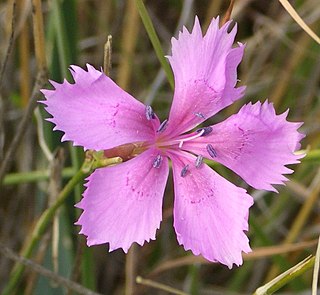
Amaranthus is a cosmopolitan genus of annual or short-lived perennial plants collectively known as amaranths. Some amaranth species are cultivated as leaf vegetables, pseudocereals, and ornamental plants. Catkin-like cymes of densely packed flowers grow in summer or fall. Amaranth varies in flower, leaf, and stem color with a range of striking pigments from the spectrum of maroon to crimson and can grow longitudinally from 1 to 2.5 metres tall with a cylindrical, succulent, fibrous stem that is hollow with grooves and bracteoles when mature. There are approximately 75 species in the genus, 10 of which are dioecious and native to North America with the remaining 65 monoecious species endemic to every continent from tropical lowlands to the Himalayas. Members of this genus share many characteristics and uses with members of the closely related genus Celosia. Amaranth grain is collected from the genus. The leaves of some species are also eaten.

Amaranthaceae is a family of flowering plants commonly known as the amaranth family, in reference to its type genus Amaranthus. It includes the former goosefoot family Chenopodiaceae and contains about 165 genera and 2,040 species, making it the most species-rich lineage within its parent order, Caryophyllales.

Alternanthera is a genus of flowering plants in the family Amaranthaceae. It is a widespread genus with most species occurring in the tropical Americas, and others in Asia, Africa, and Australia. Plants of the genus may be known generally as joyweeds, or Joseph's coat. Several species are notorious noxious weeds.

The Gomphrenoideae are a subfamily of the Amaranthaceae.

Pfaffia is a genus of plants in the family Amaranthaceae.

Chamissoa is a genus of flowering plants in the family Amaranthaceae of the Caryophyllales order.

Aerva is a genus of plants in the family Amaranthaceae. Its species are native to the palaeotropics, throughout continental Africa, Madagascar and smaller islands, through parts of the Middle East, India, and southeast Asia. Aerva javanica is an alien in northern Australia.

Blutaparon is a genus of flowering plants in the family Amaranthaceae. They are coastal plants that occur in the tropics and subtropics in the Americas, Asia, and western Africa. Plants of this genus were long known as Philoxerus, a similar Australian genus.

Froelichia, or snakecotton, is a genus of plants in the family Amaranthaceae.
Froelichia nudicaulis is a species of plant in the family Amaranthaceae. It is endemic to Ecuador.

Salsola is a genus of the subfamily Salsoloideae in the family Amaranthaceae. The genus sensu stricto is distributed in central and southwestern Asia, North Africa, and the Mediterranean. A common name of various members of this genus and related genera is saltwort, for their salt tolerance. The genus name Salsola is from the Latin salsus, meaning "salty".

Josef Aloys Frölich or Alois von Frölich was a German doctor, botanist and entomologist. He is not to be confused with Franz Anton Gottfried Frölich (1805–1878), his son, also an entomologist but specialising in Lepidoptera.

Ptilotus R.Br. is a genus of approximately 120 species of annual and perennial herbs and shrubs in the family Amaranthaceae. All species are native to mainland Australia, although one species, Ptilotus spathulatus (R.Br.) Poir., also occurs in Tasmania and another, Ptilotus conicus R.Br., in Malesia on the islands of Flores and Timor. Most of the diversity is in Western Australia, particularly in the Pilbara. Common names for species in this genus include mulla mulla, foxtails, pussy tails and lamb's tails. The genus was first formally described by botanist Robert Brown in Prodromus Florae Novae Hollandiae in 1810. In family-level phylogenetic studies, Ptilotus has been placed within a clade informally known as the 'aervoids'. It has been resolved as monophyletic and is closely related to Aerva Forssk. An interactive key to the species of Ptilotus is available at KeyBase.

Caryophyllales is a diverse and heterogeneous order of flowering plants that includes the cacti, carnations, amaranths, ice plants, beets, and many carnivorous plants. Many members are succulent, having fleshy stems or leaves. The betalain pigments are unique in plants of this order and occur in all its families with the exception of Caryophyllaceae and Molluginaceae.
F. gracilis may refer to:

Haloxylon is a genus of shrubs or small trees, belonging to the plant family Amaranthaceae. Haloxylon and its species are known by the common name saxaul. According to Dmitry Ushakov, the name borrowed from the Kazakh "seksevil". In modern Kazakh language, the shrub is called "seksewil".

Megalorhipida is a genus of moths in the family Pterophoridae described by Hans Georg Amsel in 1935. Species in this genus are distributed in pantropical and subtropical climates. The species typically nests on host plants in the families Nyctaginaceae, Amaranthaceae, Fabaceae, Goodeniaceae, Asteraceae, and Verbenaceae. The generic name is often misspelled as Megalorrhipida. The species formerly placed in the genus Antarches are now considered to belong to this genus.
Quaternella is a genus of flowering plants in the amaranth family Amaranthaceae, endemic to Brazil. They are shrubs or subshrubs found mostly in the cerrado biome.

Froelichia floridana is a species of flowering plant in the genus Froelichia, in the amaranth family (Amaranthaceae). It is known as prairie cottonweed, Florida snakecotton, large cottonweed, field snakecotton, or plains snakecotton. An annual, it produces white woolly flowers on tall flowering stalks, growing up to 40 in (1,000 mm) in height. The narrowly oblanceolate to elliptic leaves are opposite, occurring on the lower third of the stem. It grows in central and eastern North America, from the Great Plains to Mexico, east to the Atlantic Coast. Its propensity to spread easily has resulted in it being considered an agricultural weed and it is an invasive species in Australia.

Herbstia is a monotypic genus of flowering plants belonging to the family Amaranthaceae. It only contains one species, Herbstia brasiliana(Moq.) Sohmer It is within the Amaranthoideae subfamily.















